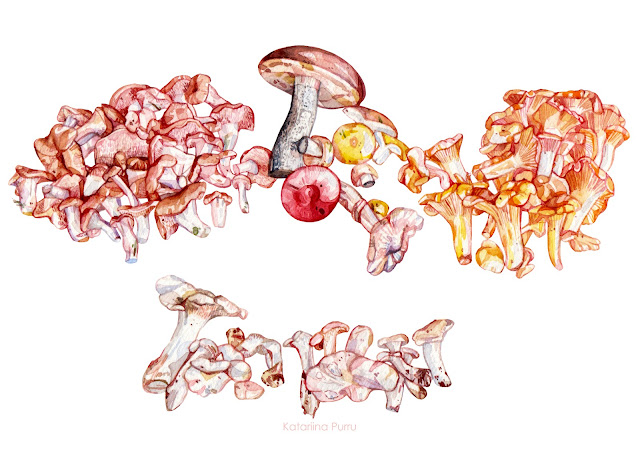Before gathering wild mushrooms please note:
- If gathering for eating, only gather mushrooms that you know for sure and you know that are edible.
- Don't forget, there are many poisonous mushrooms, that can be deadly.
- Do not experiment with foraging mushrooms. You have to know how to differentiate between mushroom species.
- Avoid gathering old mushrooms.
- Do not gather mushrooms that are near populated and industrial areas and that are close to the railroad or the highway.
- Some mushrooms need to be parboiled before they can be eaten. If they're not parboiled, they can be poisonous.
- Any person who eats mushrooms, is responsible for the consequences.
It's mushroom season! It means you can now get fresh mushrooms either from the farmer's market or gather them from the forest if you know good places. There's a joke here in Estonia that good mushroom spots are state secrets. No one likes to reveal their spots.
However, if you manage to get your hands on some edible wild mushrooms, here are some ideas on what to do with them:
- Frying - this is one of the easiest and usually the first thing you should do before using mushrooms in other recipes. Simply add the mushrooms to the pan, cook until the liquid from the mushroom evaporates, add butter, onions, maybe a little garlic and fry until the onion looks glassy. Sprinkle with some salt and pepper and enjoy as a side dish or stir into other dishes, i.e sauces. If you have some parasol mushrooms, coat them in flour, egg and breadcrumbs and fry them in some oil. When the parasol mushroom is fried like that, it gets a very meaty texture and taste. You won't regret it! The good thing is that you can also put the fried mushrooms into your freezer and then enjoy them during the winter.
- Pickling - this has to be the most common way to preserve mushrooms here in Estonia. Many families have jars of pickled mushrooms somewhere that are eaten during important celebrations, like Christmas or birthdays. The mushrooms are pickled in vinegar and usually together with onions and carrots.
- Soup - this usually requires frying the mushrooms beforehand. If using dehydrated mushrooms, soak the mushrooms in water before and then add the mushrooms together with the liquid to your soup. This is also the perfect way to celebrate autumn because mushroom soup really makes you feel all cozy and warm inside.
- Baking - if you want something to surprise your friends and family with, this one is it. You can make a mushroom galette for example, that not only is easy to make, but is also delicious and looks amazing. Or maybe add some mushrooms to a focaccia with red onions. Adding mushrooms really brings out the bready/yeasty flavour of the focaccia. Maybe you want to add some umami to a pizza? Bake your pizza with mushrooms!
- Dehydrating - this is perfect if you have a lot of mushrooms that you want to preserve. Also the simplest way to preserve mushrooms. Speaking from experience, you can dehydrate mushrooms in an oven but I'd highly recommend using an dehydrator. If the dehydrating goes wrong in the oven(i.e the temperature wasn't low enough), you'll end up with mouldy mushrooms down the line. You can use dehydrated mushrooms in several dishes either by just adding them to the dish and letting them soak up the liquid from the dish or you can rehydrate the mushrooms in water before you add them to the dish. Dehydrated mushrooms can also be used in making salt or even flour. Boletus mushrooms due to their strong taste make excellent salt. Simply grind up some dehydrated mushrooms and salt in a food processor and you have mushroom salt. You can use that in soups to add some mushroom taste to it. Dehydrated parasol mushrooms however can be used to make mushroom flour. When you grind them up, they get this floury texture that you can use making meat balls for example.



Comments
Post a Comment